Locoweed is a common name in North America for any plant that produces swainsonine, an alkaloid harmful to livestock. Worldwide, swainsonine is produced by a small number of species, most of them in three genera of the flowering plant family Fabaceae: Oxytropis and Astragalus in North America, and Swainsona in Australia. The term locoweed usually refers only to the North American species of Oxytropis and Astragalus, but this article includes the other species as well. Some references may incorrectly list Datura as locoweed.

Astragalus is a large genus of over 3,000 species of herbs and small shrubs, belonging to the legume family Fabaceae and the subfamily Faboideae. It is the largest genus of plants in terms of described species. The genus is native to temperate regions of the Northern Hemisphere. Common names include milkvetch, locoweed and goat's-thorn. Some pale-flowered vetches are similar in appearance, but they are more vine-like than Astragalus.

Astragalus alpinus is a species of flowering plant in the legume family known by the common name alpine milkvetch. It has a circumpolar distribution, occurring throughout the upper latitudes of the Northern Hemisphere.
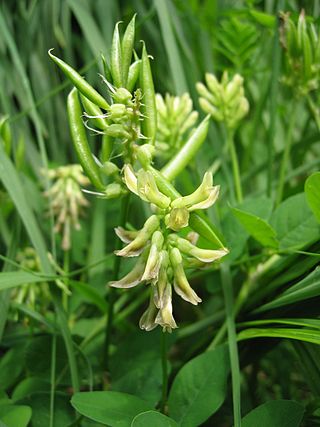
Astragalus glycyphyllos is a flowering plant in the family Fabaceae, native to Europe. It is a perennial herbaceous plant which is sometimes used for tea.

Astragalus canadensis is a common and widespread member of the milkvetch genus in the legume family, known commonly as Canadian milkvetch. The plant is found throughout Canada and the United States in many habitats including wetlands, woodlands, and prairies.

Astragalus bisulcatus, commonly called two-grooved milkvetch or silver-leafed milkvetch, is a leafy perennial with pea-like flowers. It is native to central and western North America, and typically grows on selenium-rich soils. It accumulates selenium within its tissues, and when livestock consume it, the selenium can be toxic.

Astragalus lentiginosus is a species of legume native to western North America where it grows in a range of habitats. Common names include spotted locoweed and freckled milkvetch. There are a great number of wild varieties. The flower and the fruit of an individual plant are generally needed to identify the specific variety.

Astragalus filipes is a species of milkvetch known by the common name basalt milkvetch. It is native to western North America from British Columbia to California to Utah, where it grows in many types of habitat, especially dry areas.

Astragalus kentrophyta is a species of milkvetch known by the common name spiny milkvetch. It is native to western North America from central to west Canada, to California, to New Mexico. It grows in rocky mountainous areas, such as the Sierra Nevada, and on plateaus.

Astragalus oocarpus is a rare species of milkvetch known by the common names San Diego milkvetch and Descanso milkvetch.

Astragalus purshii is a species of milkvetch known by the common names woollypod milkvetch and Pursh's milkvetch.
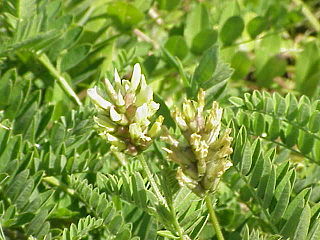
Astragalus cicer, the chickpea milkvetch, chick-pea milk-vetch or cicer milkvetch, is a perennial flowering plant native to Eastern Europe, popularized and subsequently transported to areas in Southern Europe, North America, and South America. It produces pods that resemble those of chickpeas. Its flowers are usually of pale yellow tint, and attract bumble or European honey bees for pollination. Growth often exceeds 0.6 meters, up to a height of 1 meter in length.
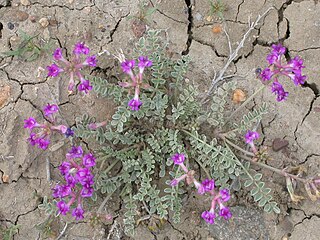
Astragalus missouriensis is a species of flowering plant in the legume family known by the common name Missouri milkvetch. It is native to central North America, where it is common and widespread.

Astragalus australis is a species of flowering plant in the legume family known by the common name Indian milkvetch. It is native to much of the Northern Hemisphere, including northern North America, Europe, and temperate Asia.

Astragalus utahensis, commonly called the Utah milkvetch, is a species of plant in the legume family.
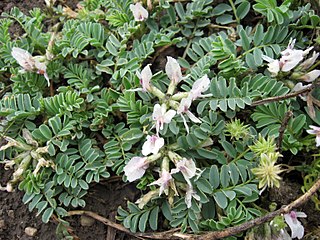
Astragalus cibarius, commonly called the browse milkvetch, is a species of plant in the legume family.
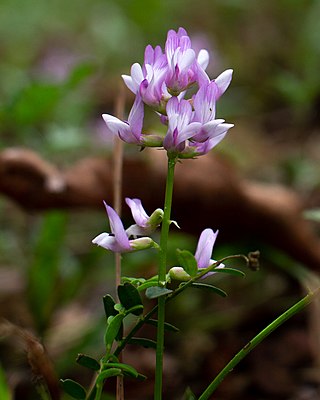
Astragalus distortus is a species of flowering plant in the legume family known by the common name Ozark milkvetch. It is found in the central United States. Missouri has a wide distribution of this plant, but is uncommon or absent in the northwestern and southeastern sections of the state. The species is subdivided into two varieties, neither of which is particularly common. There is no vine on the plant in Missouri, and it has small, purple inflorescences. Identifying characteristics include its small size, non-vining habit, and its inflorescences. It is a perennial herb. Its habitats include prairies and savannas.

Astragalus crassicarpus, known as ground plum or buffalo plum, is a perennial species of flowering plant in the legume family, Fabaceae, native to North America. It was described in 1813. The fruit is edible and was used by Native Americans as food and horse medicine. It is a host of afranius duskywing larvae. It is also known as groundplum milkvetch and pomme de prairie.
Astragalus plattensis, the Platte River milkvetch, is a species of flowering plant in the legume family, Fabaceae, native to North America. It was named in 1838. Its range includes the Great Plains of the United States, from southern Montana and North Dakota south to central Texas.

Astragalus neglectus, or Cooper's milkvetch, is a species of flowering plant in the family Fabaceae native to northeastern North America.



















